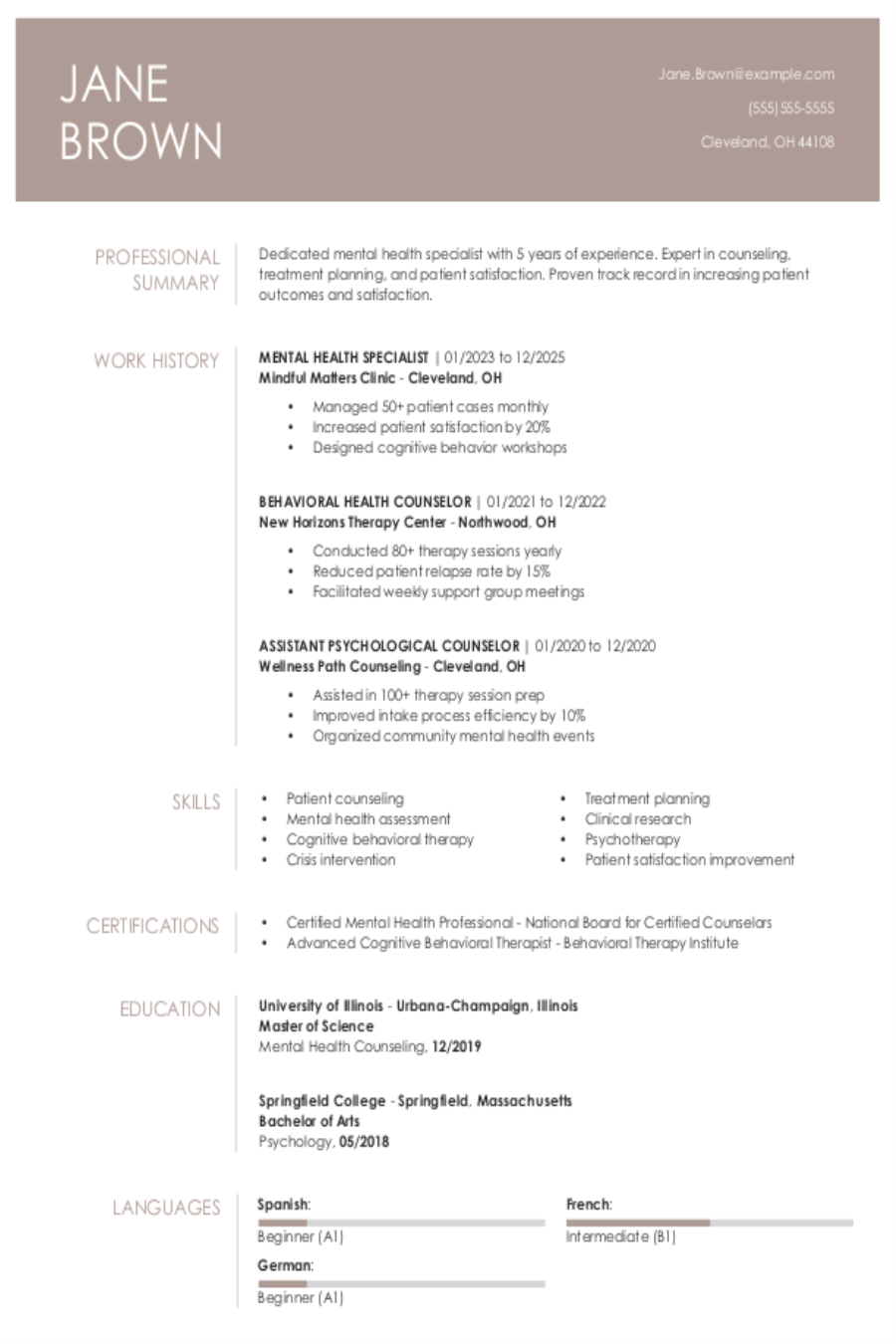Table of contents
Popular Superintendent Resume Examples
Entry-level superintendent resume
An entry-level resume for a superintendent should focus on relevant education, leadership skills, certifications, and any hands-on experience in leadership-focused roles that have prepared the candidate to assume the responsibility of a superintendent role.
Focuses on goals: The applicant demonstrates a proactive approach to educational leadership through their recent roles, emphasizing achievements in student performance and staff retention while pursuing ongoing professional growth and development.
Emphasizes soft skills: This resume highlights the applicant's strong leadership and strategic planning skills, which effectively compensate for limited experience.
Mid-career superintendent resume
A mid-career superintendent's resume should emphasize a combination of leadership experience, strategic skills, and ongoing professional development to effectively demonstrate their commitment to educational excellence.
Includes mix of skills: This resume effectively highlights a superintendent's skill in both strategic planning and community relations, illustrating a well-rounded skill set that improves educational leadership capabilities.
Balances skills and experience: The resume demonstrates a strong mix of strategic planning and community engagement skills while illustrating significant career advancement from education coordinator to superintendent, highlighting effective leadership in the educational sector.
Experienced superintendent resume
An experienced superintendent resume should prioritize highlighting leadership achievements and project management successes in a clear format that demonstrates professional growth over time.
Embraces modern design: This modern resume template effectively showcases the job seeker's dynamic leadership style and commitment to educational excellence, reflecting their innovative approach to fostering student success and operational improvements.
Quantifies achievements: Quantifiable achievements provide clarity and impact to a resume, making it easier for recruiters to evaluate a applicant's contributions. For example, highlighting a 15% increase in student performance or $50K in annual savings clearly demonstrates effectiveness and results.
More resume examples
Superintendent Resume Template
Looking to create a standout resume? This professional superintendent template is ready for you to personalize and make your own.
Samantha Thompson
Cleveland, OH 44102
(555)555-5555
Samantha.Thompson@example.com
Professional Summary
Dynamic leader enhancing education systems, achieving efficiencies, and driving student success.
Work History
Superintendent
Greenfield School District - Cleveland, OH
July 2023 - October 2025
- Improved student performance by 20%
- Reduced operational costs by $50,000 annually
- Implemented new curriculum for 1,000 students
Assistant Principal
Riverbank High School - Cincinnati, OH
January 2021 - June 2023
- Enhanced student safety measures by 30%
- Led a team of 20 educators
- Developed academic programs generating $10K
Educational Consultant
Insight Education Solutions - Columbus, OH
January 2020 - December 2020
- Optimized resource allocation by 15%
- Trained staff on innovative teaching methods
- Boosted client satisfaction scores by 25%
Skills
- Leadership
- Curriculum Development
- Budget Management
- Team Building
- Conflict Resolution
- Data-Driven Decision Making
- Community Engagement
- Strategic Planning
Certifications
- Certified Educational Leader - Illinois Board of Education
- Advanced School Management - National School Leaders Institute
Education
Master of Education Educational Leadership
University of Illinois Urbana-Champaign, Illinois
May 2019
Bachelor of Arts Education
Central Illinois University Carbondale, Illinois
May 2017
Languages
- Spanish - Beginner (A1)
- French - Intermediate (B1)
- German - Beginner (A1)
Must-Have Skills on a Superintendent Resume
A strong skills section is important for showcasing your qualifications on a resume.
The following data highlights the most sought-after hard and soft skills relevant to the superintendent role based on insights from industry experts.
When you’re ready to improve your resume with skills, check out our AI Resume Skills Generator. It provides tailored suggestions for hard and soft skills aligned with your job title, ensuring your skill set stands out.
Writing Your Superintendent Resume
With a solid understanding of effective resume examples, you're now prepared to dive into the intricacies of how to write a resume. We'll walk you through each segment step by step, ensuring you craft a compelling document that stands out.
List your most relevant skills
An effective skills section on your superintendent resume should clearly highlight both your technical expertise and essential soft skills while including relevant keywords from the job listing.
When crafting this section, think about what makes a successful superintendent. Consider including skills like leadership, communication, and policy development. By incorporating these keywords from the job listing, you present yourself as an ideal applicant who understands the role's demands and is prepared to meet them head-on.
Example of skills on a superintendent resume
- Effective communicator with a proven ability to collaborate across diverse stakeholder groups, including educators, administrators, board members, and community partners.
- Strong communicator with the ability to collaborate effectively with diverse teams
- Expertise in policy development and safety compliance
- Results-driven leader focused on optimizing project efficiency and quality
A strong skills section combines hard and soft skills, demonstrating a job seeker's technical skill along with the ability to work well with others. This balance showcases readiness for managing projects while fostering teamwork and communication.
Highlight your work history
The work experience section of your resume is where you can highlight not just what you've done, but the achievements that set you apart. Focus on quantifiable results and specific projects that demonstrate how you’ve made an impact in your previous roles.
Each job entry should include key information such as your title, the name of the employer, and the dates you were employed. This format helps employers quickly identify your professional background and assess your experience level. Make sure to include any relevant certifications or training that may improve your credibility in the field.
Example of a superintendent work experience entry
- Superintendent
XYZ School District – New York, NY
June 2018 – Present - Oversaw district operations, ensuring strategic initiatives were completed on time and within budget
- Led and supported 30+ school leaders and departments, improving overall district performance by 15%
- Implemented and monitored safety and compliance protocols, resulting in zero major incidents over two years
- Fostered strong partnerships with school boards, families, and community stakeholders, increasing engagement and satisfaction by 20%
- Introduced innovative resource management strategies, reducing operational costs by 10% while maintaining high educational standards
Highlighting outcomes and achievements in your experience section is important for capturing employer attention. By showcasing the specific results of your efforts, you demonstrate not just your skills, but also your ability to drive success and overcome challenges. This approach provides a compelling narrative that sets you apart from other applicants who may simply list daily responsibilities.
Include your education
The education section of your superintendent resume should showcase your academic qualifications in reverse-chronological order, beginning with the most recent degree. Include relevant degrees and certifications while omitting high school diplomas if you hold a bachelor's degree or higher. This approach highlights your advanced qualifications and sets a professional tone.
For those currently pursuing further education or who have incomplete degrees, it is advisable to list the highest completed level along with an expected graduation date. You can also include bullet points that detail significant coursework or accomplishments directly related to the role of a superintendent. This strategy is particularly effective for recent graduates or current students.
Common certifications for a superintendent resume
- Superintendent Certification – New York State Education Department
- Professional Educator License (PEL) – New York State Education Department
- School Building Leader (SBL) Certification – New York State Education Department
- School District Leader (SDL) Certification – New York State Education Department
Showcase publications and research
As a superintendent, showcasing your publications section on your resume is important for demonstrating your expertise and leadership within the educational field. Publications not only highlight your knowledge of educational policies and practices but also reflect your commitment to advancing the profession. By effectively presenting these credentials on your resume, you reinforce your credibility and authority as a leader in education.
Consider creating a dedicated publications section when you have numerous works to highlight, illustrating a robust contribution to the field. If you possess only one or two publications, integrate them into sections such as education or relevant experience for brevity. Ensure that you follow an appropriate citation style (like APA or Chicago) that aligns with academic standards, making it easier for reviewers to recognize your contributions.
Example of a publications section
- Smith, J. & Johnson, A. (2024). "Innovative Strategies for School Leadership". Journal of Educational Administration, 39(1), 15-29.
- Doe, R., Lee, T., & Brown, M. (2023). "Impact of School Climate on Student Achievement". Educational Research Quarterly, 8(2), 45-60.
- (). "Contributed to the "Improving Student Engagement" project analyzing effective teaching practices.". .
- Chen, H., Johnson, A., et al. (2022). "Collaborative Approaches in Urban Education Reform". Urban Education Review, 27(3), 201-215.
Sum up your resume with an introduction
Creating a compelling profile section on your resume is important for making an immediate impact. This brief introduction serves as your first opportunity to showcase who you are and what you bring to the table.
If you have substantial experience in education administration or related fields, a professional summary is a powerful tool. This concise overview allows you to present your most notable achievements and skills right at the beginning of your resume. If you have limited experience, consider writing a goals-focused resume objective that emphasizes your dedication to career growth.
Professional summary example
Proactive superintendent with over 10 years of experience in educational leadership. Demonstrated success in improving school performance, optimizing resource allocation, and fostering positive learning environments. Expert in curriculum development, staff training, and community engagement.
Resume objective example
Enthusiastic superintendent eager to apply strong leadership and communication skills to improve school operations and foster a positive learning environment. Committed to leveraging organizational abilities and team collaboration to drive student success and support staff development in a forward-thinking educational setting.
When crafting your resume profile for a superintendent position, it's important to incorporate relevant keywords from the job description. This section is your first chance to highlight key qualifications that align with what employers are seeking. By doing so, you improve your chances of passing through ATS systems and catching the hiring manager's attention.
Add unique sections to set you apart
Improve your resume by incorporating optional sections that highlight your unique qualifications for superintendent roles. These sections allow you to stand out, demonstrating not just your professional experience but also what makes you a distinctive applicant.
By including relevant hobbies and volunteer experiences, you can illustrate the skills and values that drive your work ethic. Whether it's coaching a local sports team or engaging in community service, these activities provide insights into your leadership style and commitment to education. Show employers how your passions align with the role of a superintendent and reflect your dedication to fostering a positive environment for students and staff alike.
Three sections perfect for a superintendent resume
- Leadership experience: Highlight your ability to guide teams and projects successfully. Detail roles where you managed staff, budget oversight, or strategic planning, emphasizing accomplishments like improved efficiency or project completion ahead of schedule.
- Project management skills: Showcase your expertise in organizing and completing projects. Include examples of successful projects you've led, tools or methodologies used, and the impact on the organization or community.
- Community engagement: Demonstrate your commitment to fostering relationships within the community. Mention initiatives you've led, partnerships formed, and positive outcomes that resulted from these efforts.
5 Resume Formatting Tips
- Choose a format that matches your career stage.
Selecting the right resume format is important for showcasing your experience. If you're seasoned in your field, a chronological resume highlights your career progression effectively. For those just starting out, a functional resume can emphasize skills over work history. Consider a combination format if you have varied experiences that you want to present cohesively.
- Pick a smart resume template.
Using a professional resume template improves the readability of your document. It allows hiring managers to quickly understand your qualifications and experience. If you decide to create your own format, opt for clear layouts and ATS-friendly fonts to maintain clarity and professionalism.
- Select an appropriate font.
Opt for a clear and professional font to improve the readability of your resume. Choosing fonts like Arial, Calibri, or Georgia ensures both ATS compatibility and a polished appearance for human reviewers.
- Use consistent formatting.
Align your resume to the left with uniform margins. This creates a clean and polished look that improves readability and makes a strong professional impression.
- Keep your resume to one or two pages.
When crafting your resume, remember that resumes should be one page long. If you have extensive experience, two pages may be acceptable, but ensure your content remains concise and highlights what matters most to potential employers.
What’s the Average Superintendent Salary?
Superintendent salaries vary based on location, career level, and qualifications.
This data, provided by the Bureau of Labor Statistics, will show you expected salary ranges for superintendents in the top 5 highest-paying states, including the District of Columbia. The figures reflect the most current salary data available, collected in 2024.
- Full Range
- Most Common (25th–75th percentile)
- Average
Florida
Most common: $91,590 - $109,870
Rhode Island
Most common: $90,980 - $101,250
Puerto Rico
Most common: $93,000 - $104,850
California
Most common: $89,790 - $106,500
New Jersey
Most common: $91,210 - $103,200
Tools for Your Job Search
Are you ready to apply for that superintendent position you've been aiming for? Before submitting your application, consider using our ATS Resume Checker. This invaluable tool provides insights on how well your resume is likely to perform with the automated systems many educational institutions and districts use for initial screening.
Need a boost in showcasing your qualifications? Our AI Resume Builder offers tailored recommendations specific to your experience as a superintendent, along with professional templates designed to highlight your leadership skills and achievements effectively.
Frequently Asked Questions
Last Updated: October 9, 2025
Absolutely. A cover letter is important as it adds depth to your resume and creates essential communication opportunities with employers. It allows you to express your enthusiasm for the superintendent role and highlight how your unique experiences make you an ideal applicant. Don’t overlook this chance—write a cover letter that showcases your passion and qualifications.
For a quick and effective solution, try our AI Cover Letter Generator. It simplifies the process of creating personalized cover letters tailored to specific job applications in just minutes. Plus, you can choose from various cover letter template options that align perfectly with your resume for a polished presentation.
A resume is generally a concise document, spanning one to two pages and highlighting your most relevant skills and experiences. In contrast, a CV (curriculum vitae) can extend several pages, providing comprehensive details about your academic background, research contributions, publications, and professional experience.
When applying for positions in academia, science, law, or medicine, you’ll likely need a CV rather than a resume. If you're unsure how to create an effective CV, our online CV Maker is the perfect solution! Choose from various tailored CV templates designed for different industries and career levels to craft your ideal CV in just minutes.
Absolutely, essential skills such as "project management" and "team leadership" are important on superintendent resumes. It's also beneficial to analyze job descriptions for additional keywords that employers prioritize.
To improve your networking skills as a superintendent, regularly reach out to former colleagues and build those connections. Consider joining organizations specific to educational leadership. Keeping your LinkedIn profile current will also help you engage with industry trends and opportunities, ensuring you're always in the loop.
To excel in your superintendent interview, practice common job interview questions and answers. This preparation will boost your confidence and help you handle any unexpected topics that may arise during the conversation.
In your resume, briefly state your aspirations as a superintendent, such as "Dedicated educator aiming for leadership roles." Use your cover letter to elaborate on your goals, detailing how specific positions align with your growth. Focus on opportunities that improve your skills and promote professional development in education leadership.
Was this information helpful? Let us know!
Hailey is a career advice writer dedicated to helping job seekers excel in their careers.
More resources

What Is an ATS Resume? How to Write an ATS-Friendly Resume in 2025
The rise in applicant tracking systems (ATS) means resumes nee...

How to Use Resume Now’s Resume Builder for Free
Try Resume Now s AI-powered Resume Builder for free to access ...





